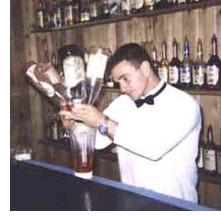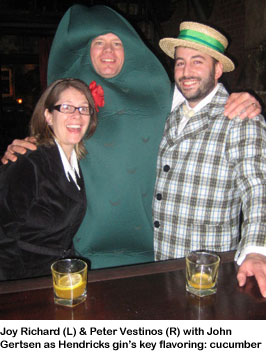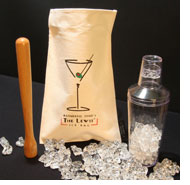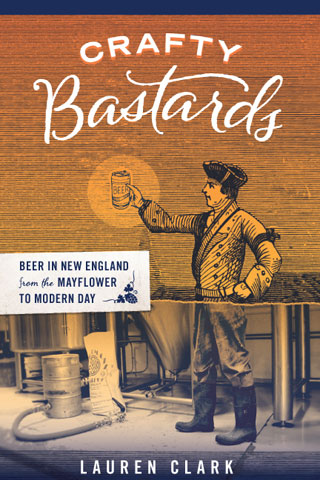Archive for the ‘Drinking supplies’ Category
April 7th, 2009

Finally, a bartending class for the armchair mixologist. It’s called Home Bar Basics, and it’s happening on April 13 at the Boston Shaker, Adam Lantheaume’s store within a store at Grand in Union Square (374 Somerville Ave.). Remember? He’s the guy who’s selling hard-to-find cocktail ingredients, books and tools. Well, now he’ll show you how to mix a proper drink. From the course description:
Want to start making cocktails at home but are befuddled by the different tools, ingredients and recipe instructions? Do the drinks you make at home never come out as well as the ones you have out? Want to understand some of the “hows and whys” of making cocktails? Check out this hands-on workshop!
It’s $30, and the best thing is you can buy tix online.
Tags: Boston Shaker, cocktail classes, Grand, home bartending, somerville
Posted in Books & resources, Drinking supplies, Events | 3 Comments »
March 1st, 2009
A few spirited nips for you on this snowy Sunday…
Tremont 647 director of operations Joy Richard, aka Bourbon Belle of the Boston chapter of Ladies United for the Preservation of Endangered Cocktails, deserves a shout-out. She recently traveled to L.A. to compete in the Hendricks gin Marvelous Limerick & Cocktail Competition.
You may remember how Richard qualified for this gig: by winning Hendricks’ Beantown Bartender Battle at Green Street last summer. Contestants mixed an original Hendricks cocktail that highlighted the botanicals used to flavor the gin, and they penned an accompanying limerick about their potion. Check out the recipe for Richard’s drink, Nobody’s Darling, and her limericks at LUPEC Boston’s blog.
 “The competition itself was in this incredible bar called the Edison, which I believe was L.A.’s first electric company. The space was like nothing I’ve ever seen,” Richard said.
“The competition itself was in this incredible bar called the Edison, which I believe was L.A.’s first electric company. The space was like nothing I’ve ever seen,” Richard said.
“We were judged on the following points: 1. costume (theme: Victorian Steampunk); 2. limerick; 3. cocktail name, and why you named it what you named it; 4. cocktail taste; and 5. showmanship.”
Alas, our clever Bostonian did not take home the trophy that night. It went to Peter Vestinos from the Wirtz Beverage Group in Chicago for his drink, A Cotswold Afternoon.
Meanwhile, a group of amateur mixologists competed in TV Diner’s annual cocktail contest on NECN. The entries in this competition fall largely in the silly-vodka-drink camp — first place went to the jailbait-appropriate Dreamy Banana Tini — but the classic cocktail revival made a showing with the second-place finisher, the Father’s Advice.
“I couldn’t believe that I placed at all. Seriously: gin and raw egg?” quipped the drink’s creator, James Slaby, who has been a regular at drinkboston.com and LUPEC Boston events. He presents his cocktail — “halfway between a Ramos Fizz and a Gin Flip” — in this clip from the show.
Father’s Advice (a morning-after tonic)
1 ½ oz Plymouth gin
¾ oz Baines pacharan (a Spanish cordial)
¾ oz fresh lemon juice
½ oz light cream
½ oz simple syrup
½ teaspoon Regan’s Orange Bitters
8 drops Fee’s Brothers Whiskey Barrel-Aged Bitters
1 fresh, whole egg
Healthy grind of fresh black pepper
1 dried star anise
Pour liquids into shaker half-full of cracked ice. Add egg and fresh pepper. Shake vigorously for 60 seconds. Strain into a well-chilled sour glass or rocks glass. Float star anise on top.
Finally, check out this Bostonist interview with Adam Lantheaume of the Boston Shaker, a first-of-its-kind boutique for Boston-area cocktailians that I wrote about not long ago.
Tags: cocktail contests, ingredients, LUPEC Boston, mixology, Recipes
Posted in Bartenders, Cocktails, Drinking supplies, Gin, Nips | 7 Comments »
December 3rd, 2008

If you’re looking for mixology tools, exotic bitters and newly reissued cocktail books of yore, head to Grand in Union Square, Somerville (374 Somerville Ave.). The Boston Shaker, a fledgling local enterprise headed by Adam Lantheaume, recently helped Grand set up a section for these items amidst the store’s merchandise for devotées of design.
The photo above gives you an idea of the sort of cocktail accoutrements you’ll find at Grand: Fee Bros. bitters (orange, mint, whiskey-barrel aged, etc.), syrups (orgeat, cassis, etc.), bar spoons, shakers, ice crushers, jiggers, cocktail books. No spirits, however — Grand is not a liquor store. (Bitters contain alcohol, but, like extracts used in cooking, they are not consumed in great enough quantity to warrant regulation.)
You can also contact the Boston Shaker directly to order these goods, as well as to get info on procuring hard-to-find spirits. And, note to industry folks: the Boston Shaker would love to talk to you about supplying your bar with specialty cocktail tools and ingredients. So, if you’re in the market for, say, an absinthe fountain or cherry bitters, give Adam a shout.
Tags: cocktail ingredients, cocktail tools, shops
Posted in Bitters, Books & resources, Drinking supplies | 3 Comments »
April 25th, 2008
 By Scott N. Howe
By Scott N. Howe
In these times of global unrest and economic anxiety, I’ll admit that my concern over what is the proper platform on which to set my $10 cocktail is frivolous at best. Still, I continue to be plagued by the fact that, in the finest bars across our fair city, my drinks are consistently placed on flimsy paper napkins that quickly become wet and stick to the bottom of my glass, creating a moist mess that deeply dampens my enthusiasm for the entire cocktail experience.
At beer joints, this problem does not exist. Those places have stacks of sturdy cardboard coasters at the ready. After you take your seat and place your order, an attentive bar guy or gal will deal out coasters like a Vegas pit boss. Shortly thereafter, your frothy mug or frosty glass is plunked atop one of these colorful, practical discs and — no muss, no fuss — the bon temps can roulez.
In a cocktail establishment, the process is, of course, more refined and more involved. A drinks list is studied, the mixologist on duty is, perhaps, consulted to offer a recommendation or clarify a question on ingredients, history or flavor profile. Then, when the decision has been rendered, the magical matters of mixing, muddling, shaking and stirring commence, resulting in a custom creation that is carefully poured in the appropriate vessel and placed ever so delicately on (wait for it) a thin white paper napkin.
Look, I understand where our city’s serious bartenders are coming from. If I just spent 10 minutes crafting a drink based on an 1890 recipe found in an obscure pamphlet I discovered at a Paris flea market — a recipe that, after much experimentation, I had altered to incorporate a drop of liqueur made by Austrian monks from tulip stems and a dash of my own secret stash of homemade bitters — I would not want to serve said drink on a cardboard coaster trumpeting the “2008 Coors Light Spring Break Ultimate Swag Giveaway.” I get it.
Still, can’t we come up with a compromise? Sturdier napkins, perhaps? Custom doilies bearing, subtly, the logo of some high-end liquor company?
Let’s work on this problem, people. Once we settle the coaster conundrum, we can take a look at this global warming thing.
Tags: coasters, napkins
Posted in Drinking supplies | 9 Comments »
February 29th, 2008

“Shake well with ice.”
The vast majority of recipes for straight-up cocktails instruct you to do this, but what does shaking (or stirring) “well” really mean? I occasionally give advice to home bartenders, and the main thing I find myself repeating is, “Shake/stir your cocktail until it’s really, really cold. You can leave a cocktail on ice longer than you think.” People are always surprised to hear this, because they heard somewhere once that bartenders are shiftless characters who will carelessly “water down” your drink unless you keep them on their toes. It’s not until these misguided drinkers have tasted a cocktail that’s been properly watered down, by a skilled bartender who knows his/her way around a shaker, that they realize what they’ve been missing during all those years of drinking tepid, poorly mixed booze.
But I find myself at a loss when the person I’m advising asks, “OK, but for how long do I shake the drink?” Well … it depends on the cocktail, the ice, the vigorousness of the shaking … In short, there’s not really a standard response. So I’m offering here the next best thing: expert advice. I posed these questions to several of Boston’s best bartenders: “How do you gauge when a cocktail’s cold enough — when your hand aches from holding the icy shaker? Do you count the number of shakes/stirs? For the home bartender’s sake, can you estimate the number of seconds (or even minutes) a typical cocktail should take to chill perfectly?” Their responses are below. Read them, and you’ll be able to wow the guests of your next cocktail party by demonstrating a “dry integration shake.”
NOTE: I didn’t really get into the whole matter of different types of ice, which some bartenders obsess over in their quest for the perfectly chilled drink. (That’ll be the subject for another day — this post’s long enough). That said, if you don’t have a Lewis Bag in your house, make sure you read to the end.
Rob Kraemer, Chez Henri
I go ’til my hand sticks to the shaker, probably under 20 seconds if shaking hard. Too long dilutes the drink fast, but I’m interested to see what other responses you get, as I don’t even think about it.
Ben Sandrof, No. 9 Park
As far as shaking a drink, I usually give egg drinks about a minute of shaking, unless of course it’s a fizz, in which case it’s a bit longer. If it’s a stirred cocktail, about 20 seconds does the trick. The key is that we are looking for approximately 20 to 30 percent ice melt in the cocktail, as well as the appropriate amount of chill. I could be a real nerd and tell you that there is a thermometer on hand to make sure the drinks are, as finished products, between 28 and 30 degrees, but let’s not go there yet…
Brother Cleve, freelance mixologist and cocktail historian
“When your hand aches from holding the icy shaker.” That’s really when I put it down. I recall going to the Blackbird in NYC when Dale DeGroff and Audrey Saunders were the bartenders, back in the late ’90s. I was really impressed with Dale’s shaking technique (over the shoulder, very fluid movements, and for a long time). I asked him about the length of time he would shake for, and he explained that he felt that the longer shaking time added, and mixed, the additional water the drink required to be balanced, especially since they used pretty large ice cubes. Generally, frost on the metal shaker indicates that it’s ready. I guess it works out to be a minute or two. I’ll shake longer if there’s dairy or eggs involved.
If I’m shaking with crushed ice, I do it for less time, as it adds more water at a more rapid rate. Same thing with blender drinks. Most tropicals should be done at high speed for five to 10 seconds, max.
Tom Schlesinger-Guidelli, Eastern Standard
In all honesty, I would say that both shaking and stirring are, at this point, second nature. It is really about feel, tasting a drink … is it balanced? Does it need more water to balance it out? Shaking or stirring are, at their most basic, about waterizing. I would say, in most scenarios, it is not necessarily about getting “appropriately cold” (though that is a wonderful secondary side effect). Instead, I think about properly waterizing that drink first, and how that usually offers you the proper temperature.
There are a number of different of types of shakes as well, each depending on what it is you are actually shaking. Many of Boston’s bartenders use a “dry shake” [a shake without ice, usually followed by a shake with ice] on egg drinks, arguing that it creates better texture in a drink. Some of us don’t necessarily buy into that philosophy. Then there is the “integration shake,” basically a quick two or three shakes, used to make the different liquids come together better. It’s one we use a lot, both for drinks like the Whiskey Smash, which ends up being strained over crushed ice, and for a lot of sparkling cocktails, like the Belle du Jour or even a French 75. In the Whiskey Smash example, you even use one further breakdown, a dry integration shake. It is for this reason that I think it is really hard to give an answer to “how long?” With a sort of mainstream everyday cocktail it is probably in the range of 30 or so shakes, maybe somewhere around 20 seconds.
In terms of stirring, I usually teach new bartenders to stir their cocktails until the shaker frosts over. That, to me, is kind of an easier distinction, particularly if you are stirring out of a [metal] shaker rather than a glass.
 Now, a piece of advice from little old me: Before you make a cocktail at home, crack your ice. The cubes from your standard freezer tray are nice and hard and dense — much better in quality than most “quick-melt” bar ice, I’ve heard bartenders say — but, with their smooth surfaces, they’re a little too slow to melt in your shaker. So empty a tray of cubes into your Lewis Bag, and give the bag a few hard wacks with the accompanying wooden mallet. Cracked ice + ample shaking/stirring time = great cocktails.
Now, a piece of advice from little old me: Before you make a cocktail at home, crack your ice. The cubes from your standard freezer tray are nice and hard and dense — much better in quality than most “quick-melt” bar ice, I’ve heard bartenders say — but, with their smooth surfaces, they’re a little too slow to melt in your shaker. So empty a tray of cubes into your Lewis Bag, and give the bag a few hard wacks with the accompanying wooden mallet. Cracked ice + ample shaking/stirring time = great cocktails.
Tags: coldness, ice, shaking, stirring, temperature, water
Posted in Bartenders, Cocktails, Drinking supplies | 5 Comments »






